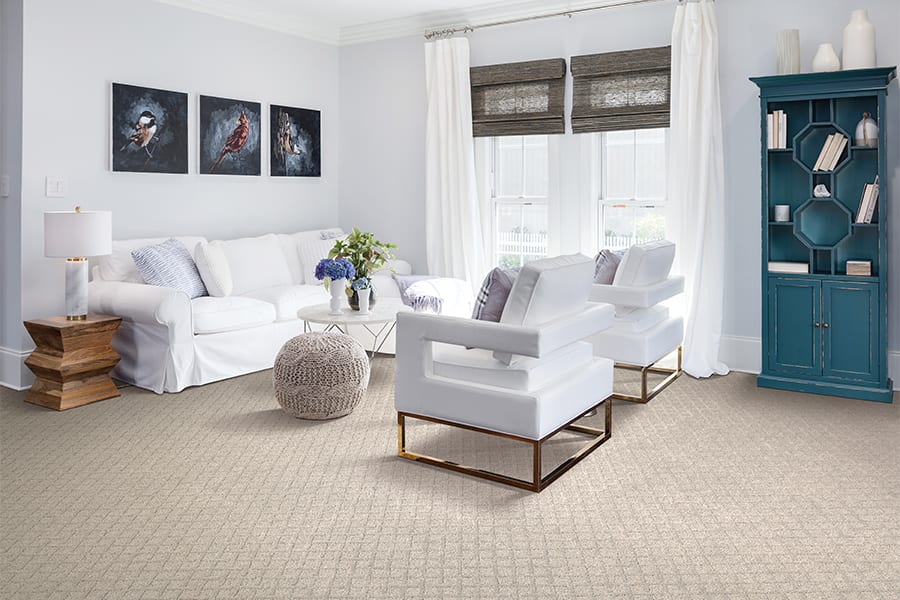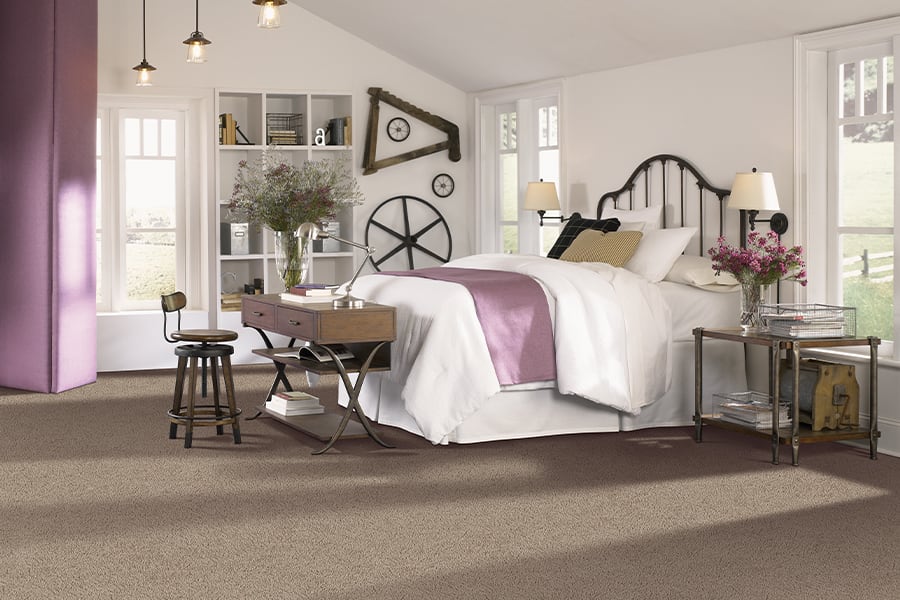Carpet
When it comes to carpet, there are literally thousands of different styles and colors. In fact, there’s so much that it can be confusing to determine what the perfect carpet is for you. That’s why at Garvey’s, our sales staff and interior designers are perpetually trained on the latest advances in the industry. Carpet ten years ago is not what it is today, which is why it’s especially important to talk to an expert that has been trained with the latest information. Have you ever bought a computer only to find it obsolete in six months from the date you bought it? Well, with carpet it’s not quite that bad, but continuous changes in fiber construction, stain resistance, and the way a carpet wears are all things that manufacturers try to improve on every day.
When you buy at Garvey’s, you can be absolutely positive that you are receiving first quality materials that are the latest that the industry has to offer, and that it will be installed according to strict manufacturer guidelines. When you buy carpet from us (or anything from Garvey’s), you're covered for the life of that carpet. With any major investment, it’s that kind of assurance that you need to have.
When you buy at Garvey’s, you can be absolutely positive that you are receiving first quality materials that are the latest that the industry has to offer, and that it will be installed according to strict manufacturer guidelines. When you buy carpet from us (or anything from Garvey’s), you're covered for the life of that carpet. With any major investment, it’s that kind of assurance that you need to have.
Why choose carpet?
- Carpet’s cushioned surface absorbs sound and is less noisy to walk on than hard surface flooring.
- Affordability, carpet is one of the most economical flooring products to have installed.
- The insulating properties of carpet provide additional warmth underfoot during cold seasons.
- Carpet is a non-slip surface that is safe underfoot and provides a cushion to prevent breakage when delicate items are accidentally dropped.
- Most synthetic carpets are treated with static, stain and soil resistant treatments, making them easy to clean and maintain
There are a number of reasons why carpet is a great choice for many of the rooms in your home. Garvey’s Flooring America offers a wide selection of quality carpets in a variety of styles, fibers and colors.
Below, you will find an overview of all of the choices. Still unsure of what will best suit your needs for your home? Our experienced sales staff can help you to make the right choice for your personal style and decor.
Get in touch
Which fiber to choose?
Nylon
Nylon is the most durable and stain resistant carpet fiber available. It is the fiber of choice for homes with pets and children and for those who entertain a lot. Perfect for heavy traffic in hallways and stairs.
Polyester
Polyester is known for its luxurious look, feel and wonderful selection of colors and styles. It’s a good value for homes with a normal amount of traffic.
Olefin
Olefin offers good stain and moisture resistance, but scores below nylon and polyester for wearability. It can be a good choice in loop pile construction although its colors and styles are limited.
Wool
Favored for its natural beauty. It has natural soil resistance quality, but is not inherently stain resistant. Wool looks good for a long time and is well constructed.
Nylon is the most durable and stain resistant carpet fiber available. It is the fiber of choice for homes with pets and children and for those who entertain a lot. Perfect for heavy traffic in hallways and stairs.
Polyester
Polyester is known for its luxurious look, feel and wonderful selection of colors and styles. It’s a good value for homes with a normal amount of traffic.
Olefin
Olefin offers good stain and moisture resistance, but scores below nylon and polyester for wearability. It can be a good choice in loop pile construction although its colors and styles are limited.
Wool
Favored for its natural beauty. It has natural soil resistance quality, but is not inherently stain resistant. Wool looks good for a long time and is well constructed.
Carpet construction
Over 90% of residential carpet is manufactured as tufted carpet. A tufting machine works like an oversized sewing machine with hundreds of needles that insert loops of fiber (tufts or stitches) into the carpet’s backing to form the face pile of the carpet.
How long your carpet will last depends on how well it is made. Quality construction will affect the durability, appearance and price of the carpet and is most influenced by the twist of the fibers and the density of the tufts.
Twist
Twist refers to how tightly the fiber (carpet yarn) has been twisted. This is especially important in cut pile carpet because the tips are exposed and can become untwisted, giving the carpet a matted and worn appearance. The tighter the yarn is twisted, the better the carpet will stand up to crushing and matting.
Frieze carpet has the highest twist level at about 7-9 twists per inch (TPI), whereas most cut pile carpet styles have between 3-6 twists per inch.
Density
Density refers to both the amount, and how tightly packed together the fibers are within the carpet. The closer together the fibers are placed, the denser the carpet will be, and the better it will wear and perform.
Ways to check for carpet density include trying to reach the carpet backing by pressing your fingers on the carpet fibers. The more difficult it is to reach the backing, the denser the carpet.
Or with outward facing tufts, bend the carpet into a U-shape and look at how much of the carpet backing is visible. The less backing that shows, the denser the carpet.
How long your carpet will last depends on how well it is made. Quality construction will affect the durability, appearance and price of the carpet and is most influenced by the twist of the fibers and the density of the tufts.
Twist
Twist refers to how tightly the fiber (carpet yarn) has been twisted. This is especially important in cut pile carpet because the tips are exposed and can become untwisted, giving the carpet a matted and worn appearance. The tighter the yarn is twisted, the better the carpet will stand up to crushing and matting.
Frieze carpet has the highest twist level at about 7-9 twists per inch (TPI), whereas most cut pile carpet styles have between 3-6 twists per inch.
Density
Density refers to both the amount, and how tightly packed together the fibers are within the carpet. The closer together the fibers are placed, the denser the carpet will be, and the better it will wear and perform.
Ways to check for carpet density include trying to reach the carpet backing by pressing your fingers on the carpet fibers. The more difficult it is to reach the backing, the denser the carpet.
Or with outward facing tufts, bend the carpet into a U-shape and look at how much of the carpet backing is visible. The less backing that shows, the denser the carpet.

What are the different carpet styles?
Cut pile
Cut pile consists of yarns that are cut at the ends. The soft feel of cut pile carpet makes it a perfect choice for the most comfortable areas of your home – bedrooms, living rooms and family rooms.
There are five basic styles of cut pile carpet: Velvet, Saxony, Frieze, Shag, and Cable, each provides a different look and texture. The primary difference among these styles is the amount of twist in the yarns that will ultimately influence the carpet’s durability.
Loop pile
Loop pile has yarns that are looped and uncut on the carpet surface. The pile height can vary from low, tightly constructed to a more luxurious high-level pile.
Loop pile carpet has excellent durability, strength and soil hiding capabilities. This style is ideal for heavy traffic areas. Berber is a popular style of loop pile carpet that can be constructed as a level-loop or multi-loop carpet.
Cut and loop pile
As the name suggests, this carpet has some cut piles and some that are not in order to create a different surface look and texture.
Cut & loop carpets combine good performance with luxurious comfort to add character & texture to your home.
Cut pile consists of yarns that are cut at the ends. The soft feel of cut pile carpet makes it a perfect choice for the most comfortable areas of your home – bedrooms, living rooms and family rooms.
There are five basic styles of cut pile carpet: Velvet, Saxony, Frieze, Shag, and Cable, each provides a different look and texture. The primary difference among these styles is the amount of twist in the yarns that will ultimately influence the carpet’s durability.
Loop pile
Loop pile has yarns that are looped and uncut on the carpet surface. The pile height can vary from low, tightly constructed to a more luxurious high-level pile.
Loop pile carpet has excellent durability, strength and soil hiding capabilities. This style is ideal for heavy traffic areas. Berber is a popular style of loop pile carpet that can be constructed as a level-loop or multi-loop carpet.
Cut and loop pile
As the name suggests, this carpet has some cut piles and some that are not in order to create a different surface look and texture.
Cut & loop carpets combine good performance with luxurious comfort to add character & texture to your home.














